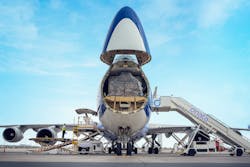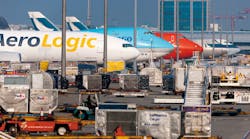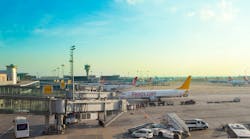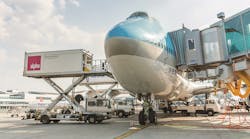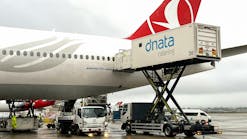How the Middle East is Handling Increased Traffic Volumes
The Middle East region is witnessing a very significant growth in the aviation industry. According to statistics computed by the International Air Transport Association (IATA) – made available at the end of 2016 – the Middle East region appears to be the only region of the world that has consistently witnessed over the last five years a double digit percentage growth year over year in terms of both passenger traffic and capacity.
“Middle Eastern airlines have one of the lower break-even load factors. Average yields are low but unit costs are even lower, partly driven by the strength of capacity growth,” reads IATA’s 2016 End-year report.
The aircraft ground handling industry has a key role to play in the context of a strongly expanding aviation industry, in order to both take advantage of the opportunities and overcome the challenges that an industry expansion implies.
One of the challenges concerns the adequacy of the aircraft ground handling infrastructure in the region to cater for increasing traffic volumes.
“Generally speaking there are no significant ground-handling shortages observed in the region today, although a few exceptions exist,” says Shamel Shishani, IATA’s regional director – airport, passenger, cargo and security for the Middle East-North Africa (MENA) region.
According to Jon Conway, director general of the Airport Services Association (ASA), it is not really just about ground handling infrastructure.
“If one takes a holistic view, it is about overall airport infrastructure – terminals, concourses, baggage handling systems etc. – in addition to air traffic management, ultimately runway capacity, and then the surrounding infrastructure (road/rail links, etc.) to support the traffic increases still very much on the horizon in the Middle East,” he says. “We ground handlers are simple folks. We like well-designed facilities, space to work and park our ground support equipment (GSE), efficient mechanical handling systems, sensible airside regulations enabling safe and efficient ground operations. I still think the industry misses a trick in not fully engaging with our sector when it comes to airport and airfield design and development. The handlers (the ultimate end user for many airport facilities) are often presented with sub optimal designs requiring either work arounds or (expensive) remedial work. This has always surprised me and I hope our recent efforts with Airports Council International (ACI) will help improve the level of engagement, especially at the planning stage. There is an enormous amount of experience out there just waiting to be used.”
There are several additional operational challenges for the aircraft ground handling companies in the Middle East in the context of an expanding industry. According to Shishani, these include security and immigration bottle-necks, a lack of proper airport-user service level agreements (SLA) with established key performance indicators (KPI) and minimum service levels for providers to start with – including ground handlers. In addition, he points out, airport operations are not being handled with a ‘supply-chain’ approach in mind that ensures all links in the chain enjoy proper communication, coordination and alignment on one ultimate customer.
“Cargo handling is not receiving a similar level of attention compared to the passenger side and, triggered by the drop in oil prices, the region is experiencing an unprecedented increase in user charge increases that is not being done according to ICAO main charging principles or industry best practices (i.e. transparency, user consultation, cost-relatedness and non-discrimination) and does not necessarily add value or improve services,” says Shishani.
“More broadly, in the Middle East and elsewhere, the reduction of injuries and ground damage on the airside is of prime concern. To this end, we are working with ground service providers and GSE manufacturers to help develop GSE specifications that call for active measures to improve operational performance such as non-contact sensors, proximity based speed limitations, etc. Paired with this is strong dialogue with aircraft manufacturers to make it possible to actively guide GSE to its interface points at the aircraft fuselage,” says Joseph Suidan, IATA’s head of ground operations.
“Typically, in a constrained environment, the handler is working with systems and infrastructure which is often operating at or beyond design capacity. There is inherently higher risk when working at an airport which is operating above design capacity,” says Conway. “Operational challenges would include – especially at peak times – maintaining quality of baggage handling, making increasingly aggressive MCT’s (baggage) and moving around the airfield where airport operators, understandably, want every piece of available real estate to park or taxi an aircraft. Staff costs are an increasingly challenging issue. Many handlers do not have the luxury of recruiting local staff – there simply is not the population – so large numbers of expatriate colleagues are required. This is beginning to become more of an issue as employee related costs escalate.”
With respect to the availability of airport infrastructure in the Middle East, indeed, it can be said it is both expanding and witnessing some bottlenecks.
“Of course there is massive development in some parts of the region, like in the United Arab Emirates, with developments at both Dubai and Abu Dhabi. The new Doha International Airport is now on line and Bahrain has extensive development plans. Saudi Arabia also has identified a major need to expand their airports and I see that country rapidly developing its airport network in the coming years,” says Conway. “Unfortunately, there are no overnight solutions. But there are plans to build and develop, e.g. Dubai World Central will ultimately serve over 200 million passengers per annum.”
“When it comes to the 30-passenger terminals on our watch list, based on the current capacity and annual growth rates, we have 15 terminals which have already reached full capacity today, one that will reach full capacity by 2017, five by 2019, three by 2020, two by 2021, three by 2023 and one by 2027,” says Shishani. “In summary, compared to other regions; MENA’s ground infrastructure is good today, with some exceptions. Many airports need to have proper planning to ensure catering for the impressive annual growth rates the aviation industry enjoys in MENA.”
The competitive scenario in the aircraft ground handling business in the Middle East region is indeed very peculiar as ground handling is more single-source than competitive in many locations with none or few options to choose from, according to Shishani.
“There is a lack of sufficient regulatory framework in many locations and in some cases regulations work against a competitive market (i.e. enforcing one size fits all pricing in some occasions), and in some cases regulations focus on addressing safety and security but do not address service quality and cost efficiency,” he says.
“The Middle East has a mixture of sole provider ground handing and some airports which have a choice. I know some airline procurement types get very hot under the collar when negotiating with a sole provider and I can understand why. However, the model selected is typically a decision made by the governing authorities – not the ground handler – and, in my experience, the commercial aspects of handling negotiations were invariably professional and mutually satisfactory. I do not see a correlation between quality and competition and I have heard a counter argument where ‘excessive’ handling licenses have led to a deterioration in quality,” says Conway.
“Huge variation exists across the region, with some locations taking advantage of the new technologies and best practices. For example, IATA Fast Travel initiatives enjoy good focus in the region. MENA comprises today 7.69 percent of the global traffic volumes, out of which 3.69 percent enjoy FT services. However, that good percentage is due to a few regional locations/players and it’s not spread across most locations/players,” says Shishani.
“A vital component that ties all of this together is better communication and harmonization between ground service providers, airlines, airports and IATA. We are developing globally applicable standards and procedures for ground operations, identifying areas where a simpler and consistent approach will benefit the industry and driving improvements to align ground operations and IATA audit programs,” says Suidan.
